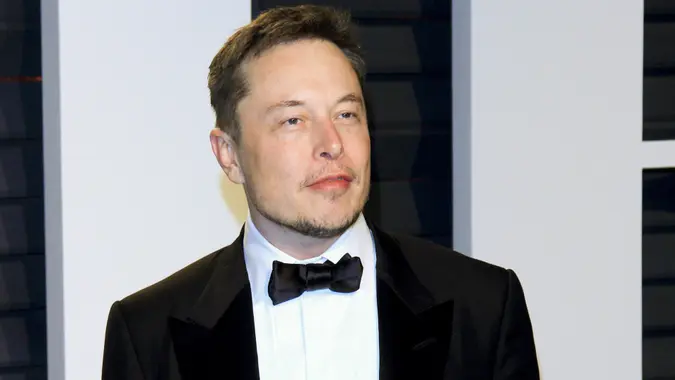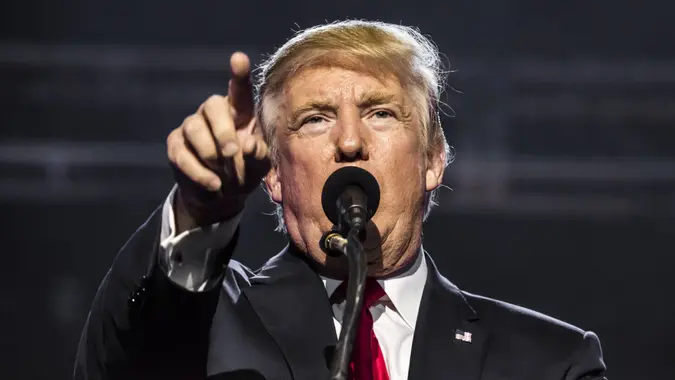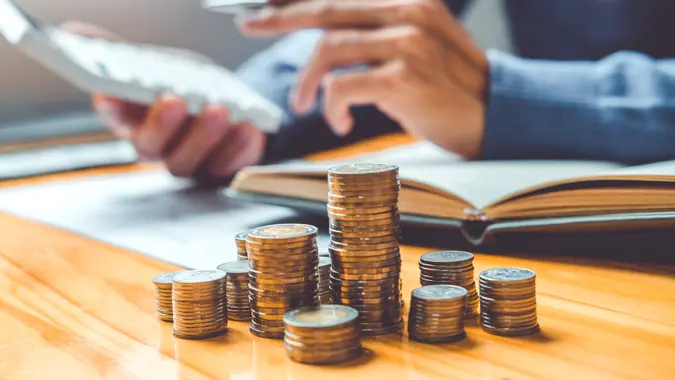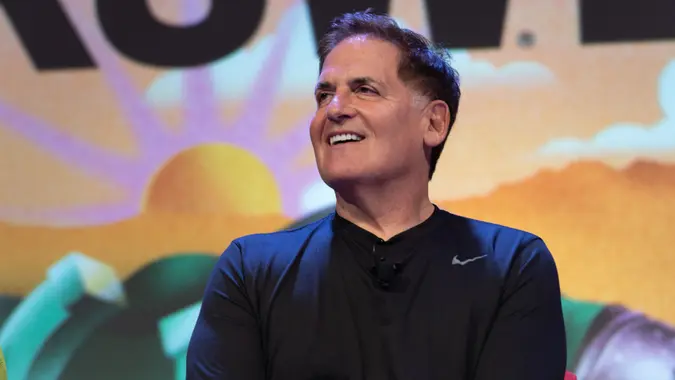CEOs Who Almost Lost Their Own Companies — Is Elon Musk and Tesla Next?

Commitment to Our Readers
GOBankingRates' editorial team is committed to bringing you unbiased reviews and information. We use data-driven methodologies to evaluate financial products and services - our reviews and ratings are not influenced by advertisers. You can read more about our editorial guidelines and our products and services review methodology.

20 Years
Helping You Live Richer

Reviewed
by Experts

Trusted by
Millions of Readers
Once upon a time, Tesla enjoyed its reputation as an innovative and futuristic automotive company, bringing in big money and without controversy. No longer is that the case. The multinational electric vehicle maker, led by CEO Elon Musk, has been the subject of heated public debates as a consequence of his political engagement.
As the de facto leader of the Department of Government Efficiency (DOGE) — which aims to cut federal spending it deems “waste, fraud and abuse,” a significant cohort of Americans feel uneasy about the world’s richest billionaire wielding the kind of power and influence Musk holds over public policy and discourse.
Tesla’s stock price is down 33.36% year-to-date as of April 24, with first-quarter sales plunging 13% — its sharpest decline in over a decade, according to CNN. Those who have become familiar with the turbulence of markets know Tesla is not the first (or last) company to experience hardships. Over time, countless publicly traded companies, including large-cap stocks, have faded into the dustbins of history. Others, however, teetered on the brink of bankruptcy but eventually survived.
Below, we will examine three case studies of CEOs who almost bankrupted their companies but were lucky enough to bounce back and three CEOs who were not so fortunate. Then, we’ll explore the future for what Tesla shareholders and prospective investors could expect in the coming months and years.
Also here’s what experts said on whether Musk should ditch politics to save Tesla.
CEOs Who Almost Lost Their Companies
Steve Jobs and Apple
The success of Apple is nothing short of extraordinary. According to The Verge, two billion people actively use iPhones, iPads, Macs and other Apple products on any given day. Yet, the ride was not always this smooth.
The late Steve Jobs once admitted that Apple was just three months away from bankruptcy in 1997, as reported by The New York Times. Facing stiff competition, declining sales and failed products, Jobs eliminated 70% of the tech company’s products — his reason? Simple: “It’s way too much stuff,” the former CEO told Forbes. Following his massive overhaul, the iMac, macOS and iPod ultimately transformed the tech company into profitability and the rest is history. By focusing on simplicity and quality products, Jobs zeroed in on what worked, while revolutionizing the industry and leaving an indelible legacy in the process.
Reed Hastings and Netflix
The streaming giant eclipsed 300 million global users at the beginning of this year, according The Wrap. For perspective, if Netflix were a country, it would rank as the fourth most populous nation on the planet, behind only the United States, China and India.
However, like Apple, Netflix also had a bumpy ride. In 2011, Hastings attempted to split Netflix’s DVD rental service from its streaming platform and introduced distinct prices for both products, effectively raising prices by 60% for users who wanted both. This costly decision angered millions of subscribers, many of whom canceled their subscriptions as retribution.
Instead of using the backlash as a learning opportunity, Hastings dismissed the concerns, comparing the increases to a “couple of Starbucks lattes.” But after losing around one million subscribers, in addition to Netflix’s share price nosediving by 19%, Hastings and his team issued a public apology, reoriented their focus on streaming and launched exclusive content that propelled the company to the top.
Howard Schultz and Starbucks
On any given week, 70% of Americans start their mornings with a fresh cup of coffee, with six in ten drinking it daily, according to the National Coffee Association. Moreover, there is no shortage of options when it comes to choice, making the coffee business insanely competitive. Despite all this, Starbucks has long been considered the crème de la crème in the landscape, as reflected in its vast network of almost 40,000 global stores.
Even so, like many businesses during the Great Recession, the multinational coffee chain faced tremendous difficulty, closing around 600 stores and seeing its net earnings plummet by 97% per a New York Times report. With time not on his side, Schultz had to act fast and respond swiftly.
At the helm of the company’s most consequential moment, Starbucks initiated a series of aggressive changes, including cost-cutting measures, reinstating key figures from Schultz’s original circle and, more importantly, redefining the brand through a nationwide training session for employees, which was more than just a shrewd tactic for good publicity; It was a plea to attract their once-loyal customers to return and experience the coffeehouse vibes they knew and loved, which worked.
CEOs Who Lost Their Companies
Richard Fuld and Lehman Brothers
At one point in time, Fuld served as one of the longest-serving CEOs among his Wall Street peers. Despite leading the commercial and investment bank through years of profitability and the turbulence of the 1998 Asian financial crisis, his ultimate undoing was the firm’s enormous exposure to risky mortgage-backed securities.
Given the steady appreciation of real estate prices and lax regulations, there was no sense of urgency to reduce the firm’s exposure to the securities mentioned above. However, when the bubble burst, things turned ugly. Real ugly. Lehman was left in the worst possible scenario: over-leveraged, overexposed and illiquid. At the start of September 2008, shares fell by 77%, according to Investopedia and by Sept. 15 (the same year), the company was forced to declare bankruptcy.
Eddie Lampert and Sears
Sears was once the largest retailer in the United States. But after years of neglecting to modernize and improve their stores, Lampert failed to seize his opportunity and lead the company into the future. Other retailers not only refurbished their brick-and-mortar locations, but also embraced e-commerce. Lampert, on the other hand, did not invest in Sears’ digital infrastructure during a critical period when the internet was expanding.
The chain’s online presence was negligible and worse, its physical stores were outdated and underfunded, which is crucial to note given Lampert’s background as a hedge fund manager. Rather than operating Sears for what it was — a department store company — he ran it too much like a hedge fund manager, through zealous cost-cutting measures and buying back stock, which generated short-term profits for shareholders but ignored long-term strategies for future success.
Years went on with abysmal sales and store closures, eventually culminating in the retailer filing for bankruptcy on Oct. 15, 2018. For nostalgic customers yearning the good old days, a handful of locations still remain open. As reported by the Tacoma News Tribune, two additional locations reopened in late 2023.
John Antioco and Blockbuster
Around 25 years ago, Reed Hastings and his business partners flew to Dallas to propose an acquisition deal to John Antioco. If the deal went through, it might have changed Antioco’s fortunes — and history. The offer was quite simple: purchase Netflix.
For $50 million, Blockbuster would have effectively bought out its new disruptive competitor and, in the process, secured its future. Instead, as Netflix co-founder Marc Randolph recounted to The Independent, the most they got from Antioco was him barely managing not to laugh at the idea. Suffice to say, his hubris got the better of him and he probably is not laughing now while thinking about what could have been.
To be fair, Netflix was not the sole reason Blockbuster failed. For instance, a significant portion of Blockbuster’s revenue was contingent on collecting late fees from renters, which, in hindsight was never a sustainable business model. Additionally, the rental chain was weighed down by massive amounts of debt as authors Todd Davis and John Higgins noted in their case study piece, aptly titled “A Blockbuster Failure: How an Outdated Business Model Destroyed a Giant.”
So, What’s the Outlook for Tesla?
As of April 2025, Tesla remains profitable, albeit not without challenges. Despite earning a net income of $7.1 billion last year, shareholders witnessed a steep decline from the $15 billion earned in 2023. While no single factor explains why this happened, most analysts attribute it to global tariffs, increased competition, reduced vehicle prices and Musk’s divisive political activities.
Furthermore, BYD Auto surpassed Tesla’s revenue in China while steadily chipping away the U.S. automaker’s presence in Europe. BYD reported to Business Insider an impressive $107 billion in revenue in China, outpacing Tesla’s $97.7 billion. Meanwhile, in Europe, Tesla’s sales declined across several key markets including France, Denmark, Sweden and the Netherlands, with numbers in France and Sweden falling for the third consecutive month — marking the lowest Q1 performance since 2021 based on a Reuters analysis.
So, will Musk drive Tesla toward the same fate as the aforementioned CEOs who bankrupted their companies? Highly unlikely (though not impossible). But will shareholders undergo more pain? That remains to be seen.
If the Tesla CEO takes some time to reassess his priorities, gets proactively involved in the company’s day-to-day and long-term affairs, while advancing stakeholder interests over his political stunts, a positive turnaround could be within reach. Alternatively, if Musk continues to align himself with President Donald Trump while centering his time and energy on DOGE, the EV maker could remain the target of protesters while alienating more customers and prospective buyers, in an already competitive landscape.
Musk, at this point, is the dynamite that could either launch Tesla into a comeback success story or a cautionary tale, depending which route he takes. “The stock has become untethered from fundamentals,” one analyst from Barclays told The New York Times, predicting investors are essentially banking on Musk’s influence in the White House and celebrity status to get the company back on track.
Editor’s note on political coverage: GOBankingRates is nonpartisan and strives to cover all aspects of the economy objectively and present balanced reports on politically focused finance stories. You can find more coverage of this topic on GOBankingRates.com.
More From GOBankingRates
Sources
- National Coffee Association, “2025 National Coffee Data Trends.”
 Written by
Written by  Edited by
Edited by 

























